|
|
||||
| home | ||||
| MORPHOSIS. Newcity Park |
||||
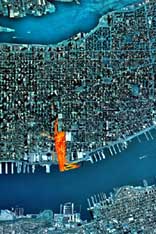 Aerial view of area in Manhattan with Newcity Park. |
The competition New York: CCA Competition for the Design of Cities, organized by the CCA (Centre Canadien d’Architecture) directed by Phyllis Lambert, consisted of a two-stage selection process. Announced in November 1998, the competition drew nominations from around the world: the names of over one hundred potential competitors were solicited from the recommendations of architects, urban designers, schools of architecture and urban planning. In February 1999 the Prize Jury winnowed down the nominees to five competitors who then participated in the second stage of the competition: Peter Eisenman, Eisenman Architects, New York City; Thom Mayne, Morphosis, Santa Monica, California; Cedric Price, Cedric Price Architects, London, England; Jesse Reiser and Nanako Umemoto, Reiser + Umemoto RUR Architecture, New York City; Ben van Berkel and Caroline Bos, UN Studio Van Berkel & Bos, Amsterdam, the Netherlands. The nine-member jury included Elizabeth Diller, Charles A. Gargano, Frank Gehry, Gary Hack, Arata Isozaki, Philip Johnson, Phyllis Lambert, José Rafael Moneo, Joseph B. Rose. The five competitors chosen for the second stage were given approximately four months to develop their design for a site located in New York City. The project focused on an area on the western edge of Manhattan, encompassing the equivalent of 16 city blocks, bordered by the Hudson River on the west and 8th Avenue on the east, 34th Street on the north and 30th Street on the south. In June 1999 the competitors presented their proposals to the competition jury which then deliberated upon a winner and presented Peter Eisenman with the CCA Prize for the Design of Cities. The proposal here presented is the one submitted by Morphosis.
[PG] |
|||
| [in italiano] | THE DESIGN PROPOSAL. The central principle of organization is a new kind of public park (Newcity Park) running from Penn Station over the rail yards and into the Hudson River, continuously infused with a great variety of public recreational, private commercial, and cultural, social and educational uses. These activities are positioned in and activate a multi-layered platform -supporting and spatially integrated with the park- and also occupy adjacent buildings continuous with the surface and in places canting over the park to create volumetric enclosures open to the sun. |
[26may2002] | ||
 Aerial view from the southwest. 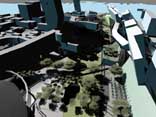 Aerial view of the park.  View from 34th Street.  Panoramic view. |
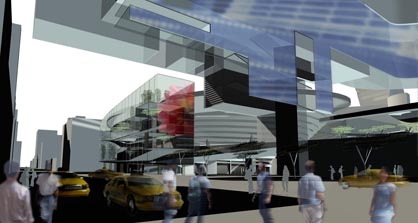 Perspective view at street level (8th Avenue). The park, the third largest in the city of New York after Central and Riverside Parks, is oriented according to the true solar east-west axis in order to optimize the penetration of sunlight to its one million square feet of public areas and greenery, and hence it is off the alignment of the urban grid. Newcity Park terminates in a floating beach platform on the Hudson River which supports a variety of year round uses, mostly tied to new hotels serving the Convention Center expansion and to a relocated ferry terminal. |
Morphosis was founded in 1972 to develop an architecture that would eshew the normal bounds of traditional forms and materials and surpass the limiting dualism of modern and postmodern. Growing steadily, the firm is currenlty comprised of 37 architects and designers directed by Thom Mayne. Thom Mayne was born in Waterbury, Connecticut in 1944. He received his Bachelor’s Degree in Architecture from the University of Southern California in 1968 and his Master’s Degree from the Graduated School of Design of Harvard University in 1978. He is one of the founding members of the Southern California Institute of Architecture (SCI-Arc), school of architecture founded by Ray Kappe in 1972. A significant percentage of Morphosis work has been commissioned through international design competitions including the Hypo-Alpe-Adria-Center in Austria, the University of Toronto Graduate Student Housing in Canada and the Diamond Ranch High School in California. They have recently begun design development for future Children’s Museum of Los Angeles, which will be a key factor for the rejuvination of Downtown Los Angeles, and serve as a landmark for the city. The firm has been the subject of various group and solo exhibitions around the world, most notably at the Contemporary Art Center in Cincinnati, Ohio and the Walker Arts Institute in Minneapolis; it has also been the subject of a major retrospective at the Netherlands Architectural Institute (NAI) in 1999. Paola Giaconia studied architecture at the Politecnico di Milano in Italy. Recipient of a Fulbright Scholarship, she graduated from the Master's Degree Program at SCI-Arc (Southern California Institute of Architecture) in 1999. After working with such architectural offices as Morphosis (Thom Mayne) and RoTo (Michael Rotondi) in Los Angeles, she founded A.polis with partner Gregory Taousson. She is the author of the recently published book Los Angeles. Città unica, released by Testo&Immagine in December 2001. |
||
| Additional private structures for office, commercial, housing, etc. are built in the areas flanking Newcity Park to the north and south (including the Convention Center expansion); they are connected to the park surface above actual grade and integrated into the surrounding built form of the existing city and its present and proposed transportation infrastructure. |
||||
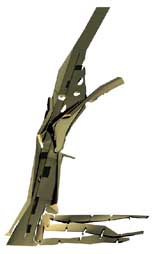 Warp. Variable plane – Surface continuity (landscapes of intersections, a place of intersection between public and private and the exploitation of the vertical dimension as a public realm). Cultural – Institutional – Open space and Greenery – Recreation – Service - Commercial. |
 "The architecture of the city must diversify to support a growing variety of population groups and individual strategies of self-fulfilment. From the interactions of differences among individuals and groups, new opportunities and problems will emerge with a transformative effect on the life of the city and its architecture. These collective transformations need to find their general expression in internally coherent geometries whose differing spatial character each supports a particular family of interchangeable uses (all uses cannot belong to any space). In this way reasonable flexibility is provided for a variety of programmatic changes over time".  |
|||
 Noodles. Continuous – Multi-Directional Linear Volume – Small – Asymmetrical. Incubator – Office – Residential – work live lofts. |
Some of these buildings are conventional in form, while others derive their unconventional shape from new conditions of connection and support generated by Newcity Park. The park will be served by its own people mover (free to the public) connecting the new Penn Station to the Hudson River. Floaters. Structures on water - Reflections. Ecolarium – Beach – Boathouse – Swimming – Shops – Restaurants and Night Clubs – Cafes – Tidal Energy Turbines. |
|||
THE PANELS. The panels represent Morphosis's proposal for the competition; they were aimed at clarifying the idea of a dynamic process with multi-scenario responses to varied forces.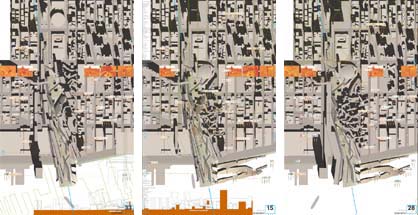 Panels. The traditional city depended on the stability of its economic and productive structure, a relative uniformity of social composition and the concentrated political power of oligarchies. These conditions were translated into a stable, homogeneous, hierarchic spatial organization. |
||||
|
|
 View #1. It is increasingly difficult today to experience the city as a linear process; it is precisely the instability of the regimes of flexible economic accumulation and the accelerating pace of change that bring the variable conditions of new urban structures to the forefront, putting into question traditional city building strategies. |
  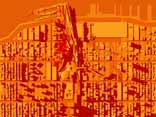 |
||
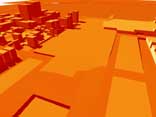   |
 View #2. A dynamic process with multi-scenario responses (no fixed solutions) to varied forces is therefore proposed. |
|||
 View #3. The proposal was built around lines of connection and displacement, operating in a topological rather than Euclidean mode. Irregular geometries represent the transformations arising from the contained conflict of competing systems – a net where relations between different elements are stressed over the continuous development of a single form. The spatial juxtaposition and programmatic adjacencies in hybrid buildings promote the three-dimensional organization of the city versus its present planimetric organization. Paola Giaconia paolagiaconia@infinito.it |
  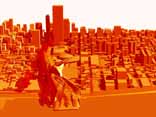 |
|||
|
MORPHOSIS. Newcity Park |
||||
|
project team: Morphosis with Design Office Thom Mayne, Marta Male with Henriette Bier, Simon Demeuse, Paola Giaconia, Steve Hegedis, Maia Johnson, Israel Kandarian, Shigehiro Kashiwagi, Scott Lee, Marissa Levin, Rose Mendez, Katsuhiro Ozawa, Janet Pangman, Patrick Tighe, Petar Vrcibradic, Erin Wengell and Design Office George Yu UCLA Professor Richard Weinstein Ove Arup and Partners Greg Hodgkinson Rare Medium, Inc. Eric Wood Brady Smith et al. Donald H. Elliott Tom Farrage/Co. Tom Farrage |
||||
|
>
MORPHOSIS > ARCHITETTURE |
||||
per partecipare alla rubrica architetture laboratorio
|
||||